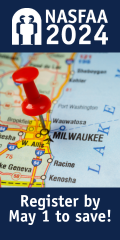NASFAA, NASPA, and MDRC Examine Strengths, Weaknesses of COVID-19 Emergency Grant Aid Program Implementation
Lessons learned from the implementation of the Higher Education Emergency Relief Fund can be used to develop a more permanent federal emergency aid program and improve institutional programs.
FOR IMMEDIATE RELEASE
Contact: Erin Powers
Director of Marketing & Communications
(202) 785-6959
[email protected]
WASHINGTON, DC, Wednesday, July 14, 2021 — Things are now beginning to return to some semblance of normalcy across the country, but the COVID-19 outbreak brought with it several revelations, one of which was the pressing and widespread need for emergency financial aid programs for postsecondary students. Though the national emergency made the general public more acutely aware that many college students were struggling to pay for basic needs, it has long been understood by institutions of higher education that more must be done to support vulnerable populations, as even relatively small financial emergencies can interrupt or permanently end a student’s postsecondary career.
In a report published today, the National Association of Student Financial Aid Administrators (NASFAA), NASPA, and MDRC, shed light on what worked well and what didn’t for postsecondary institutions in the rollout and implementation of the Coronavirus Aid, Relief, and Economic Security (CARES) Act’s Higher Education Emergency Relief Fund (HEERF). The report also offers recommendations for institutional emergency aid programs. Through HEERF, the federal government disbursed emergency funding to colleges and universities, 50% of which was required to be spent on direct grants to students for their expenses related to the disruption of campus operations due to COVID-19. Ultimately, this federal emergency aid program provided millions of postsecondary students with financial assistance during a time of worldwide crisis, but its implementation was not without missteps. Financial aid offices, trying their best to comply with regulations, were faced with changing and often conflicting guidance and communication from the Department of Education, which in some instances may have caused delays in the distribution of aid to students.
In early 2021, NASFAA, NASPA, and MDRC, using grant funding provided by the Bill & Melinda Gates Foundation, distributed an online survey and conducted focus groups to learn more about college administrators’ experiences applying for, receiving, communicating about, and distributing HEERF funds to students, and students’ experiences with those funds.
Using the data collected, NASFAA identified seven financial aid policy considerations to streamline any future federal emergency aid efforts, and place the minimum burden possible on financial aid offices, while increasing the odds that students will have access to funds before their financial emergency disrupts their progress toward their postsecondary educational goals:
-
Base the allocation formula on student headcount enrollment that includes distance education students.
-
Use the grants.gov website for requesting funds and the G5 system for disbursing emergency grant funds to institutions, and ensure funds are distributed to institutions promptly.
-
Make congressional intent clear while keeping allowable uses of funds broad.
-
Improve ED guidance and training, and deliver both promptly.
-
Make reporting requirements clear.
-
Exempt emergency aid from estimated financial aid (EFA).
-
Continue to develop emergency aid programs outside the confines of HEA Title IV programs.
“Creating and implementing the HEERF emergency grant programs was no small feat; we commend lawmakers and the Department of Education for recognizing a dire need and taking quick action to provide some relief, as well as the financial aid offices across the country that worked tirelessly to get these vital aid dollars into the hands of struggling students,” said NASFAA President Justin Draeger. “Though financial strains resulting from COVID may have subsided, the need for emergency aid programs for college students persists, and there’s much we can learn from the last year. We urge lawmakers to develop a more permanent federal emergency aid program and hope our recommendations can lay the groundwork for a smooth and successful implementation.”
Additionally, NASPA used the data to outline five priority recommendations to assist postsecondary institutions in further building and strengthening emergency aid programs:
-
Improve communication and clarity for students.
-
Assess institutional efforts and continue refining the process.
-
Ensure equity is a guiding principle.
-
Deliver timely responses and payments to students.
-
Broaden eligible emergency aid expenses.
To request an interview with a NASFAA spokesperson about findings contained in this report, please email Director of Marketing and Communications Erin Powers.
About NASFAA
The National Association of Student Financial Aid Administrators (NASFAA) is a nonprofit membership organization that represents more than 28,000 financial aid professionals at nearly 3,000 colleges, universities, and career schools across the country. NASFAA member institutions serve nine out of every 10 undergraduates in the United States. Based in Washington, D.C., NASFAA is the only national association with a primary focus on student aid legislation, regulatory analysis, and training for financial aid administrators.
About NASPA
NASPA is the professional home for the field of student affairs. Together, we are dedicated to fulfilling the promise of higher education through our guiding principles of Integrity, Innovation, Inclusion, and Inquiry. We place students at the center of our work, serving the field through exceptional professional development, research to take on our biggest challenges, advocacy for inclusive and equitable practices and communities, and nurturing networks and pipelines to mentor, rejuvenate, and support.
About MDRC
MDRC is committed to finding solutions to some of the most difficult problems facing the nation — from reducing poverty and bolstering economic self-sufficiency to improving public education and college graduation rates. We design promising new interventions, evaluate existing programs using the highest research standards, and provide technical assistance to build better programs and deliver effective interventions at scale. We work as an intermediary, bringing together public and private funders to test new policy-relevant ideas, and communicate what we learn to policymakers and practitioners — all with the goal of improving the lives of low-income individuals, families, and children.
Publication Date: 7/14/2021




